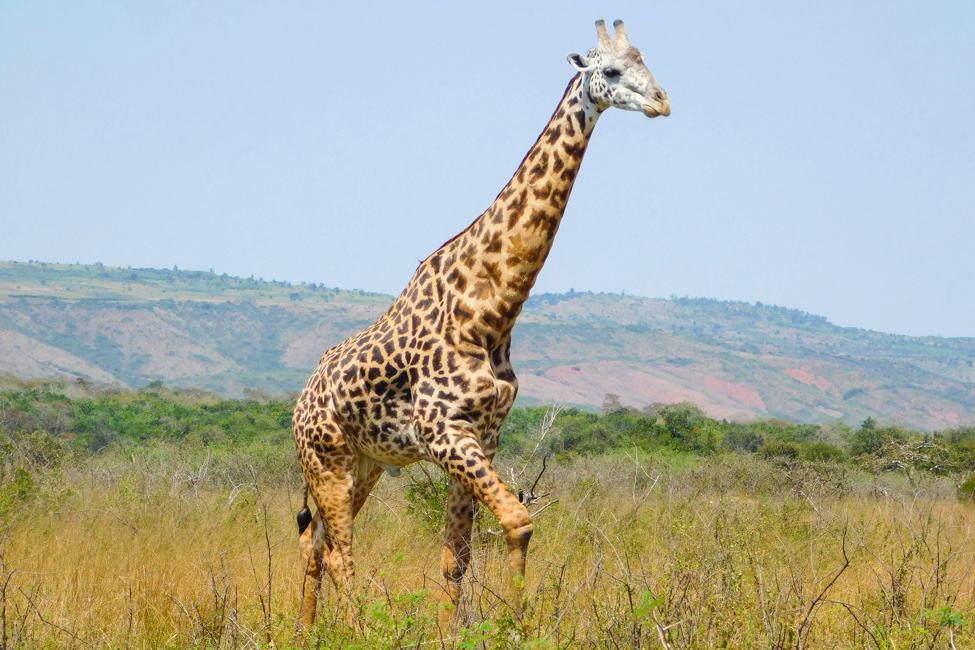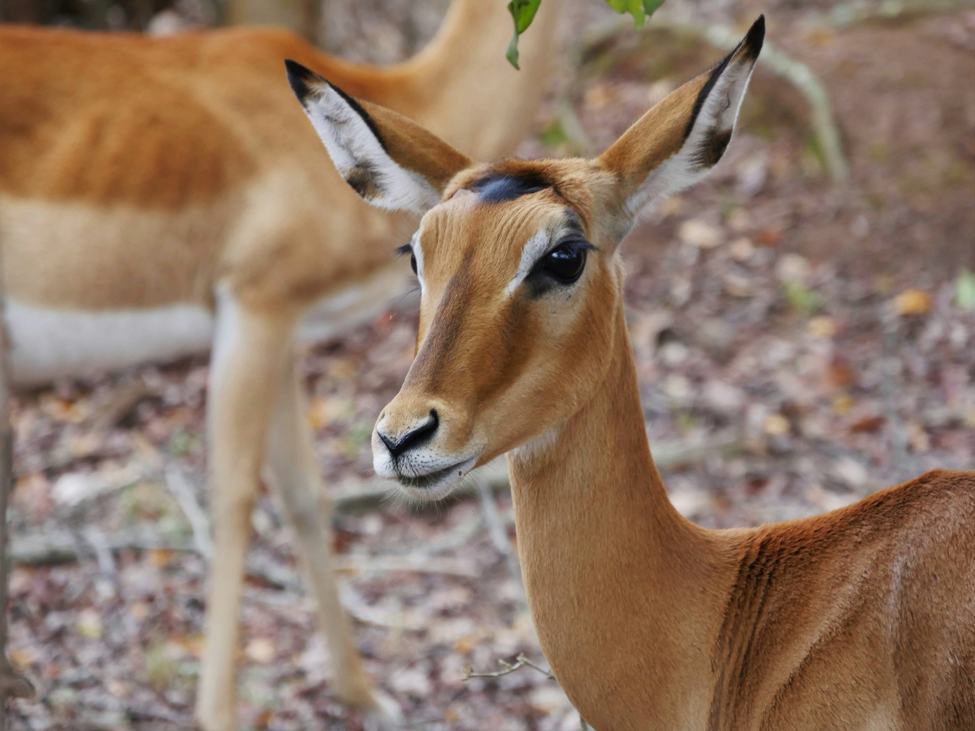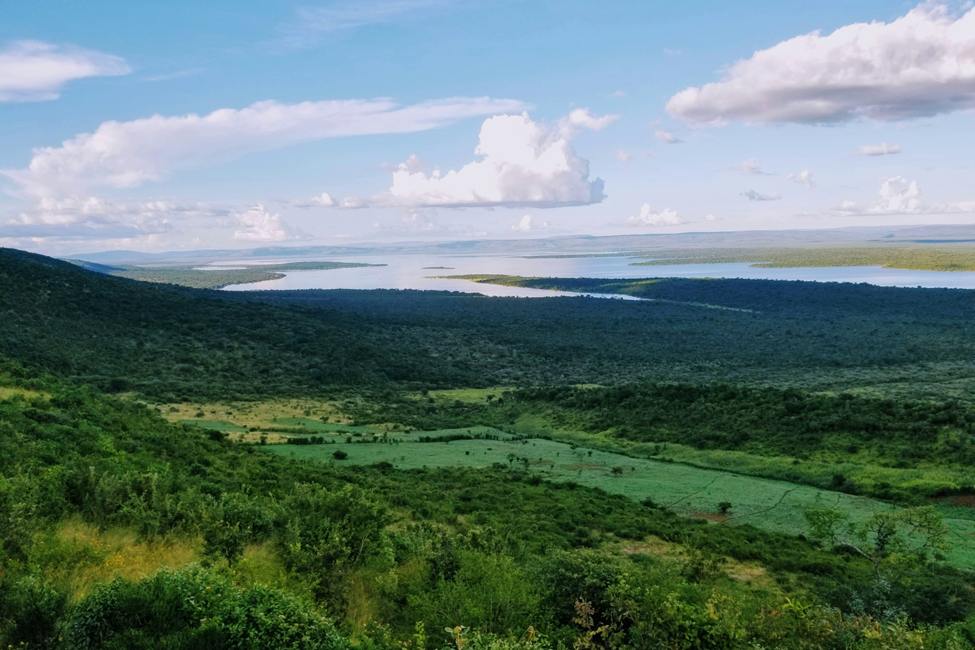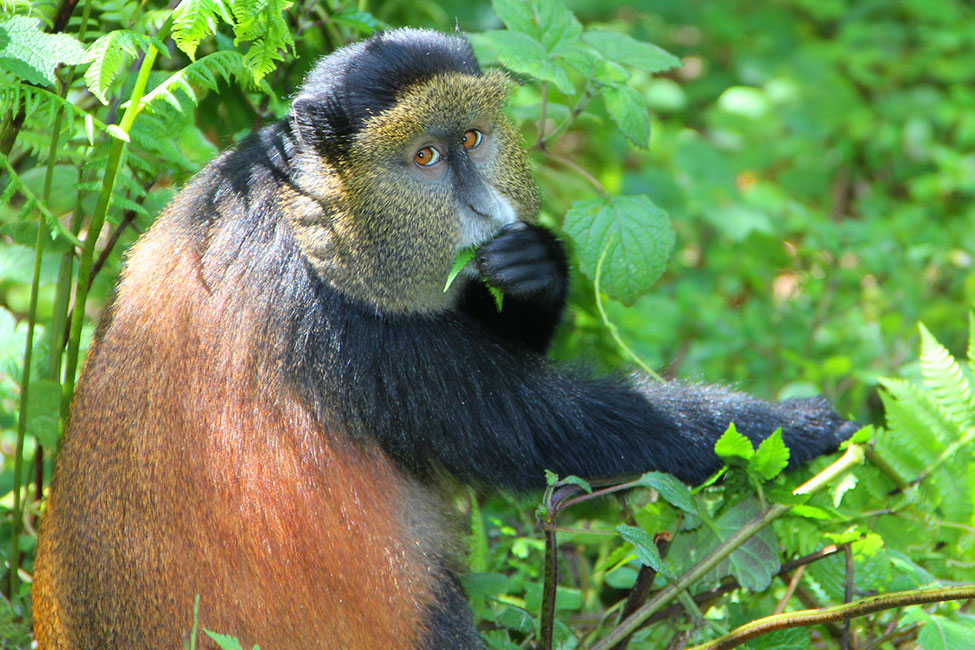Rhinos graze in Akagera National Park, Rwanda. Photo by Wiktoria West, courtesy of African Parks.
Akagera’s Thriving Wildlife Makes It a Must-See
Nestled in the northeastern corner of Rwanda, Akagera National Park is a one-of-a-kind conservation area. Contrasting with the country’s volcanic landscapes and mountain gorilla trekking experiences, Akagera offers open grasslands, wetlands, and rolling hills teeming with wildlife. Its varied terrain makes it a fantastic place to observe both the savanna animals typically associated with East African safaris and over 480 bird species, including the papyrus gonolek and red-faced barbet!
Here’s a detailed look at Akagera National Park, what makes it special, and what you can expect when you visit this spectacular part of Rwanda.

A giraffe strides through the scenic savanna of Akagera National Park, Rwanda.
What Makes Akagera Special?
Covering about 435 square miles along the border with Tanzania, Akagera is unique as Rwanda’s only savanna park. The country’s other national parks—Volcanoes, Nyungwe Forest, and Gishwati-Mukura Forest—are all in the mountains.
Akagera National Park combines several ecosystems within one park, each hosting a different cross-section of wildlife.
- Savanna: On the open plains of Akagera, you can see plant-eaters such as zebras, wildebeest, rhinos, and giraffes, as well as predators like lions, leopards, and hyenas.
- River & Lakes: Akagera gets its name from the Kagera River, which runs through the park and feeds a number of scenic lakes. Lake Ihema has one of Africa’s largest hippo concentrations, although Lake Shakani and Lake Rwanyakazinga are also terrific for hippo encounters. In addition, these lakes host crocodiles and a wide variety of bird species. You can often get good views from the roads and trails around these lakes, but we think the best views are by boat. Bring a pair of binoculars for a close look at the lakes’ fascinating shorebirds and songbirds!
- Wetlands: Akagera encompasses the largest protected wetland in central Africa. It plays a central role in preventing flooding, improving water quality, and maintaining local fisheries. A myriad of birds nest and raise their young in this food-rich environment, and it also supports mammals such as elephants, bohor reedbucks, sitatungas, and Defassa waterbucks.

A southern white rhino adjusts to its new home in Akagera National Park, Rwanda, in June 2025. Photo by Wiktoria West, courtesy of African Parks.
A Conservation Success Story
Another thing that makes Akagera so special is the amazing recovery it has shown after the devastation it suffered after the 1994 Rwandan genocide. In the instability following the genocide, poaching and habitat encroachment led to the local extinction of a number of species, including lions and rhinos.
Things began to turn around in 2010, when the Rwanda Development Board partnered with non-profit conservation organization African Parks to bring the park into a new era. Poaching of endangered species came to a halt as the park reached out to local residents with education and community development initiatives, including a sustainable tilapia farm.
Akagera’s Flourishing Wildlife
In just 15 years, the number of large mammals in Akagera has more than tripled. In 2015, lions were reintroduced to Akagera, and black rhinos were brought back in 2017 after a 10-year absence. This meant all the Big Five (elephants, lions, leopards, buffaloes, and rhinoceros) were once again living in the park!
Restoration has continued. In 2021, 30 southern white rhinos were introduced to Akagera. That number quickly grew to 41 by 2025. (White rhinos and black rhinos are separate species and, despite the names, are both gray. White rhinos are grazers who rely on grass, while black rhinos are browsers who favor leaves, twigs, and fruit.)
Then, in June 2025, an additional 70 southern white rhinos arrived at Akagera. The relocation was part of African Parks’ Rhino Rewild Initiative, which rescued 2,000 rhinos from a precarious private breeding operation in 2023. Over the next decade, the initiative will relocate the rescued rhinos to protected areas throughout Africa to supplement existing populations or create new ones where the creatures (or their northern white rhino cousins) have previously gone extinct.
The boost to Akagera’s rhino population is expected to help with the continued repair of the park’s ecosystem. According to the Rhino Rewild Initiative, white rhinos play a key role in savanna health, and savannas with rhinos have greater diversity and higher numbers of both plants and animals.
Thanks to these and other conservation efforts, Akagera is now a dynamic park and one of the most exciting places for wildlife viewing in East Africa.

Akagera National Park is home to many large antelope herds.
What to Do in Akagera National Park
Game drives
Game drives are the most popular way to experience Akagera’s rich wildlife. During the day, you’re likely to see herds of zebras, giraffes, wildebeests, Cape buffaloes, and antelopes on the savanna, as well as visually striking avians like the secretary bird and African swallow-tailed kite. You might also spot a lion on the hunt or one of the park’s impressive rhinos.
Night game drives are also available and offer a completely different experience. Under the darkened sky, the park comes alive with nocturnal creatures such as galagoes, bat-eared foxes, civets, and genets. You might also have the chance to spot an elusive leopard or hyena on the hunt.
Boat cruises
No trip to Akagera would be complete without a boat safari on Lake Ihema. You’ll get a look at the park’s hippos and crocodiles, and you’ll see a wide variety of birds, such as the African fish eagle, kingfishers, egrets, herons, and enigmatic shoebills. A boat safari offers an entirely different experience from the land-based game drives.
Explore Akagera on These Safaris
Walking safaris
While Akagera is predominantly explored by vehicle, guided walking safaris are another option for connecting with this unique landscape. The standard walking safari stretches over three nights and takes you across the park. While on your journey, you stay at a different fenced-in campsite each night, with the option to check into more luxurious accommodations at the end of your walking safari for a day or two of game drives and boating.
If a multi-day hike is too much for you, how about a morning walk along the park’s boundary fence? You’ll ascend a gentle slope, then some steeper and rockier sections before you stop to take in spectacular views down the hill and across the valley—the park with its native shrubland on one side and cultivated farms dotted with cows and goats on the other.
Finally, guests at Karenge Bush Camp can join the park’s dedicated rhino rangers on their morning walk, which they take daily to monitor the health and safety of the park’s many rhinos. You’ll follow the rhinos on foot across Akagera’s beautiful Kilala Plains.
Behind-the-scenes tour
For more insight into Akagera, take a 90-minute behind-the-scenes tour of the park headquarters to meet some of the people integral to the management of the park and learn about the park’s critical conservation activities.
Cultural experiences
While wildlife is the main attraction at Akagera, you can also enjoy a cultural experience in the surrounding communities. Watch the process of making banana beer, tour a dairy farm, or visit a honey cooperative. You’ll learn about Rwandan culture and how local communities support conservation efforts around Akagera.

Akagera National Park’s open savanna, wetlands, and rolling hills host a diversity of fascinating plants and animals.
Visiting Akagera National Park
Akagera is a year-round destination just 70 miles outside the capital of Kigali, about a two-and-a-half hour drive. The best time to visit depends on what you’re hoping to see.
From June to September and mid-December to mid-February, the weather is drier, making it easier to spot animals through the thinned-out grass and as they gather around water sources. For that reason, these are the most popular times of year to visit Akagera.
March and April see the most rain, followed by October and November, which can make some of the roads impassable. However, October and November are good months for spotting grassland birds, songbirds, and migratory birds—migrants stay in the park from November through April. The lush green landscapes are also stunning during this time.
Want to learn more about visiting Akagera? Contact Ujuzi today.
Sign up for the Ujuzi Newsletter!
From top travel tips to innovative safaris and conservation movement, get inspired to plan your next African safari!
By submitting this form, you are consenting to receive marketing emails from: . You can revoke your consent to receive emails at any time by using the SafeUnsubscribe® link, found at the bottom of every email. Emails are serviced by Constant Contact






